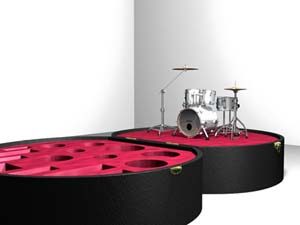Twilight, a word whose Hebrew pronunciation – dim-du-mim – contains the drum beat and the sound of silence, runs like a skyline between the works in the space. All three objects are made of materials connected with the nocturnal world, rock-n-roll music, live performance, dream and illusion. From the velvet curtain folded as a geometrical cube, through a giant suitcase for a drum set, to strips of black Gaffa (Gaffer) tape serving as brushstrokes in an abstract mural. The glamorous redundancy characterizing rock and pop is embodied by the “baroque” materials, such as furry velvet, synthetic leather, and shiny glue, typified by the inner contradiction between fake and real.
All three objects conceal the tension between the minimalist geometrical formalism of the forms and the potential narrative embedded in them. Tsabar changes and empties the objects’ original function, thus causing a basic clash between art and life, between the static quality and the potential of movement and sound. The association between the drum set and the suitcase adapted for it generates an equation that cancels and at the same time reaffirms their roles. On the one hand, the drum set charges the suitcase with an extra-artistic utilitarian narrative, and concurrently – the suitcase eliminates the usability of the system, reinforcing its formalist aspects. Similarly, the drum sticks have also been altered, and instead of wood they are made of glass, a material that will never allow the act of drumming as every encounter with the drum head will only enhance the gap of non-realization. It is this minor act that finally tilts the balance in favor of art, and the entire sculpture reverts to being an ensemble of colors and forms. In the “Gaffa” painting, the same substitution is created when the adhesive tape transforms into an artistic vehicle, changing its role.
Tsabar’s point of view is not critical. It is a yielding gaze that yearns for the live performance and the authentic sentiment innate to music, as opposed to the static quality and timelessness of art. The works oscillate between the innocent memory of a childhood fantasy and a new world revealed in twilight and nocturnal moments.
Lighting: Yair Vardi
Naama Tsabar (1982) was born in Israel. Lives and works in Tel Aviv.
Less Reading...
